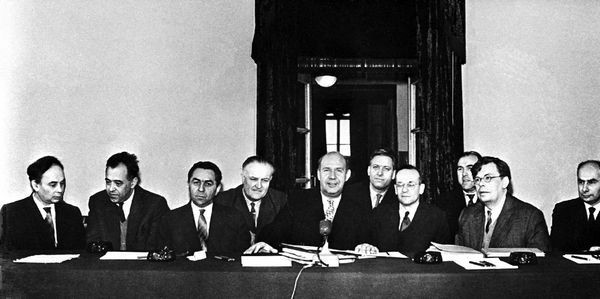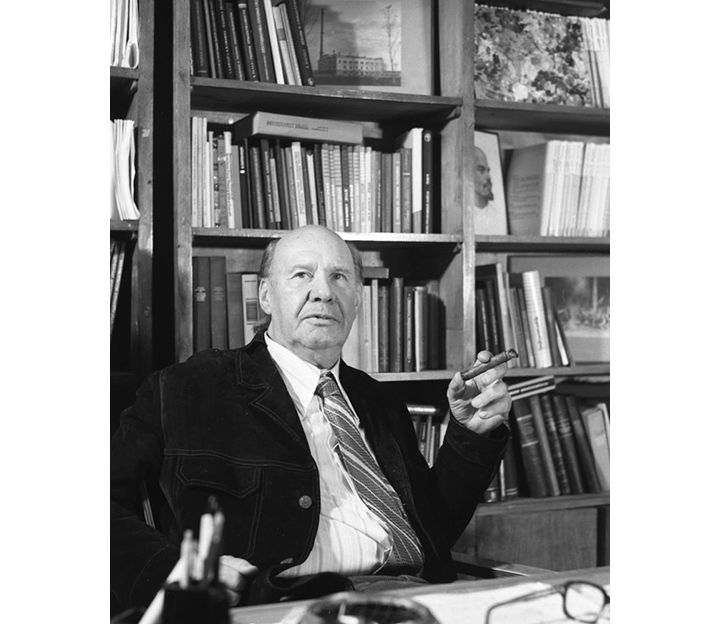Remembering founding fathers: Dmitry Blokhintsev
News, 11 January 2022
11 January marks the birth of an outstanding Soviet physicist Dmitry Ivanovich Blokhintsev, one of the initiators of the establishment of the Joint Institute for Nuclear Research and its first Director.
Dmitry Blokhintsev was born on 11 January 1908 in Moscow, in the family of the agronomist. He was fond of aircraft and rocket engineering since his childhood. He was able to do engineering drawings being a teenager, corresponded with K. E. Tsiolkovsky, as well as mastered the basics of differential and integral calculus by himself.
After graduating from the Faculty of Physics of the Moscow State University in 1930, he taught there. Since 1936, he became Professor and then the Head of the Department of Theoretical Nuclear Physics. In 1934, he defended the candidate’s dissertation on the quantum theory of solids, in a year, he obtained the degree of Doctor of Physics and Mathematics based on the results of the defence.
Merits of D. I. Blokhintsev in the fields of science organization cannot be overestimated. He was one of the creators of the Department of Nuclear Physics at the MSU Faculty of Physics. In 1935-1947, he worked at the Physical Institute of the USSR Academy of Sciences (FIAN). Since 1947, he was the Director of the scientific and research laboratory in Obninsk, which was then transformed into the Institute of Physics and Power Engineering. He supervised there the design and construction of the first in the world Obninsk Nuclear Power Plant that was put into operation in 1954.
In 1956, the Committee of Plenipotentiaries of eleven Member States of the established Joint Institute for Nuclear Research unanimously elected him the first Director of the Institute. He headed the organization until 1965. In 1965-1979, D. I. Blokhintsev was the Director of the Laboratory of Theoretical Physics JINR. He proposed the idea to create the IBR-1 and IBR-2 fast pulsed reactors at JINR.
 First members of JINR Directorate: I. M. Frank, M. Danysz, V. P. Dzhelepov, V. Votruba, D. I. Blokhintsev, V. N. Sergienko, V. I. Veksler, A. M. Ryzhov, N. N. Bogoliubov, G. N. Flerov.
First members of JINR Directorate: I. M. Frank, M. Danysz, V. P. Dzhelepov, V. Votruba, D. I. Blokhintsev, V. N. Sergienko, V. I. Veksler, A. M. Ryzhov, N. N. Bogoliubov, G. N. Flerov.
Scientific works by Dmitry Blokhintsev cover a wide range of various fields of physics. Back in 1938, he made calculations predicting the Lamb shift. He conducted research on the theory and technical issues of chain nuclear reactions and nuclear reactors. Based on the equations of gas hydrodynamics, the scientist built a theory of sound phenomena in moving and inhomogeneous environments, derived the most general-type acoustic equations (Blokhintsev equations). He used them to explain some acoustic laws, calculate acoustic phenomena in moving and inhomogeneous environments. He formulated equations of geometric acoustics. He performed one of the first works on non-linear optics, he also developed the theory of the Stark effect in a strong alternating field.
At JINR, Blokhintsev performed a number of bright works on elementary particle physics, limits of application of quantum chromodynamics, issues of high-energy particles interactions, nonlocal field theory, the concept of space and time in the microcosm. He proposed the idea of fluctuation of nuclear matter density (1957), quantum stochastic spaces, the existence of several vacuums and spontaneous transition between them. D. I. Blokhintsev indicated the existence of a unitary limit, developed a theory of ultracold neutron confinement.
He was the winner of numerous highest awards of the USSR Government and the Academy of Sciences, an Honorary Citizen of Dubna. He also was the President of the International Union of Pure and Applied Physics.
Dmitry Blokhintsev philosophically comprehended life and science, wrote poems and drew paintings in his free time. His artistic works are available in the Laboratory of Theoretical Physics and the JINR Universal Public Library named after him. There are also streets in Dubna and Obninsk named after him.
